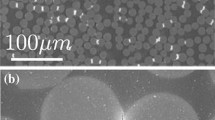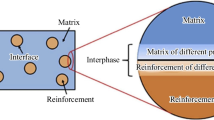Abstract
The relationship between adhesion and bond strength in thin fiber-polymer matrix systems was studied. Adhesive interaction in composite materials was analyzed within the scope of thermodynamic and molecular-kinetic theories of adhesion. Methods based on wetting are shown to give poor estimation of the work of adhesion in fiber-polymer systems, which is due to their low sensibility to donor-acceptor interactions taking place at the interface. Important information about the acidity and basicity of contacting surfaces can be obtained by using inverse gas chromatography to investigate the thermodynamics of adsorption. The calculation of the work of adhesion including acid-base interactions shows the best agreement with the bond strength in the same systems. The local (ultimate) interfacial shear strength is proposed to characterize the quality of fiber-matrix bonding. Analysis of the relationship between the work of adhesion and adhesive pressure for various systems allowed us to differentiate the dispersive and acid-base components of the local bond strength as well as to estimate distances characteristic of these two
Types of interaction. For dispersive forces, our estimation gives 7–8Å, i.e., of an order of magnitude of the center-to-center distance for van der Waals interactions. At the same time, the acid-base
Interactions have a characteristic range of 4–5Å and can be attributed to hydrogen bonding. The agreement between the calculated distances and literature data is evidence for the applicability of the proposed method to the analysis of the adhesive interaction in fibrous polymer composites.
Similar content being viewed by others
References
Yu. S. Lipatov, Physicochemical Foundations of Filling of Polymers [in Russian], Khimiya, Moscow (1991).
M. R. Piggot, “Why interface testing by single-fiber methods can be misleading,” Compos. Sci. Technol.,57, 965–974 (1997).
J.-P. Favre, G. Desarmot, O. Sudre, and A. Vassel, “Were McGarry or Shiriajeva right to measure glass fiber adhesion?” Compos. Interf.,4, 313–326 (1997).
A. Hampe and C. Marotzke, “The energy release rate of the fiber/polymer matrix interface: measurement and theoretical analysis,” J. Reinf. Plast. Compos.,16, 341–352 (1997).
R. P. Kusy and M. J. Katz, “Generalized theory of the total fracture surface energy for glassy organic polymers,” Polymer,19, 1345–1357 (1978).
K. L. Mittal, “Adhesion measurements of films and coatings,” in: K. L. Mittal (ed.), VSP, Zeist, Netherlands (1995), pp. 1–13.
A. J. Kinloch, Adhesion and Adhesives: Science and Technology. Chapman and Hall, London (1987).
D. E. Packham, “Work of adhesion: contact angles and contact mechanics,” Int. J. Adh. Adhesives,16, 121–128 (1996).
A. A. Berlin and V. E. Basin, The Foundations of Polymer Adhesion [in Russian], Khimiya, Moscow (1974).
G. S. Sheu and S. S. Shyu, “Surface modification of Kevlar-149 fibers by gas plasma treatment. Part II. Improved interfacial adhesion to epoxy resin,” J. Adh. Sci. Technol.,8, 1027–1042 (1994).
H. D. Wagner, H. E. Gallis, and E. Wiesel, “Study of the interface in Kevlar-49 epoxy composites by means of microbond and fragmentation tests: effects of materials and testing variables,” J. Mater. Sci.,28, 2238–2244 (1993).
F. P. Lui, M. P. Wolcott, D. J. Gardner, and T. G. Rials, “Characterization of the interface between cellulosic fibers and a thermoplastic matrix,” Compos. Interf.,2, 413–432 (1994).
H.-J. Jacobasch, K. Grundke, P. Uhlmann, F. Simon, and E. Mäder, “Comparison of surface-chemical methods for characterizing carbon fiber-epoxy resin composites,” Compos. Interf.,3, 275–291 (1996).
M. Nardin and J. Schultz, “Relationship between fiber-matrix adhesion and the interfacial shear strength in polymer-based composites,” Compos. Interf.,1, 172–192 (1993).
W. Gutowski, “Physico-chemical criteria for maximum adhesion. Part I: Theoretical concepts and experimental evidence,” J. Adh.,19, 29–49 (1985).
W. Gutowski, “Effect of fiber-matrix adhesion on mechanical properties of composites,” in: H. Ishida (ed.), Controlled Interfaces in Composite Materials, New York (1990), pp. 505–520.
E. Mäder, H.-J. Jacobasch, K. Grundke, and T. Gietzelt, “Influence of an optimized interphase on the properties of polypropylene/glass fiber composites,” Composites, Part A,27A, 907–912 (1996).
E. V. Pisanova and S. F. Zhandarov, “Modification of polyamide fiber surfaces by microorganisms,” J. Adh. Sci. Techol.,9, 1291–1301 (1995).
L. V. Zaborskaya, V. A. Dovgualo, and O. R. Yurkevich, “On the interaction of molten thermoplastics and fiber surfaces,” J. Adh. Sci. Technol.,9, 61–71 (1995).
Yu. S. Lipatov and V. I. Myshko, “On the relationship between adhesion and thermodynamic parameters of polymers,” Vysokomol. Soedin., Ser. A,16, 1148–1151 (1974).
Yu. S. Lipatov, Interfacial Phenomena in Polymers [in Russian], Naukova Dumka, Kiev (1980).
F. M. Fowkes, “Role of acid-base interfacial bonding in adhesion,” J. Adh. Sci. Techol.,1, 7–27 (1987).
H.-J. Jacobasch, K. Grundke, E. Mäder, K.-H. Freitag, and U. Panzer, “Application of the surface energy concept in polymer processing,” J. Adh. Sci. Technol.,6, 1381–1396 (1992).
P. H. Harding and J. C. Berg, “The role of adhesion in the mechanical properties of filled polymer composites,” J. Adh. Sci. Technol.,11, 471–473 (1997).
R. J. Good, M. K. Chaudhary, and C. J. van Oss, “Theory of adhesive forces across interfaces. 2. Interfacial hydrogen bonds as acid-base phenomena and as factors enhancing adhesion,” in: L.-H. Lee (ed.), Fundamentals of Adhesion, Plenum Press, New York (1991), pp. 153–172.
F. M. Fowkes, Physicochemical Aspects of Polymer Surfaces. Vol. 2, K. L. Mittal (ed.), Plenum Press, New York (1983), pp. 583–603.
B. V. Derjaguin, N. A. Krotova, and V. P. Smilga, Adhesion of Solids, Consultants Bureau, New York (1978).
V. Gutmann, The Donor-Acceptor Approach to Molecular Interactions, Plenum Press, New York (1983).
Yu. A. Gorbatkina, Adhesive Strength of Fiber-Polymer Systems, Ellis Horwood, New York (1992).
R. B. Henstenburg and S. L. Phoenix, “Interfacial shear strength studies using the single-filament-composite test. Pt. II: A probability model and Monte Carlo simulation,” Polym. Compos.,10, 389–408 (1989).
E. V. Pisanova and S. F. Zhandarov, “On the mechanism of failure in microcomposites consisting of single glass fibers in a thermoplastic matrix,” Compos. Sci. Technol.,57, 937–943 (1997).
J. Andersons and V. Tamuzs, “Fiber and interface strength distribution studies with the single-fiber composite test,” Compos. Sci. Technol.,48, 57–63 (1993).
W. Beckert and B. Lauke, “Fracture mechanics finite element analysis of debonding crack extension for a single fiber pull-out specimen,” J. Mater. Sci. Lett.,14, 333–336 (1995).
S. F. Zhandarov and E. V. Pisanova, “The local bond strength and its determination by fragmentation and pull-out tests,” Compos. Sci. Technol.,57, 957–964 (1997).
M. J. Pitkethly, J. P. Favre, U. Gaur, J. Jakubowski, S. F. Mudrich, D. L. Caldwell, L. T. Drzal, M. Nardin, H. D. Wagner, L. di Landro, A. Hampe, J. P. Armistead, M. Desaeger, and I. Verpoest, “A round-robin programme on interfacial test methods,” Compos. Sci. Technol.,48, 205–214 (1993).
G. Desarmot and J. P. Favre, “Advances in pull-out testing and data analysis,” Compos. Sci. Technol.,42, 151–187 (1991).
C. Marotzke, “The elastic stress field arising in the single fiber pull-out test,” Compos. Sci. Technol.,50, 393–405 (1994).
W. Beckert and B. Lauke, “Finite element calculation of energy release rate for single-fiber pull-out test,” Comput. Mater. Sci.,5, 1–11 (1996).
T. Schüller, Bruchmechanische Modellierung der Mixed-Mode-Belastung bei der Ausbreitung von Faser-Matrix-Grenzflächenrissen unter Berücksichtigung der nichtlinearen Reibungseffekte, Master Thesis, Technische Universität Dresden (1997).
T. Schüller, U. Bahr, W. Beckert, and B. Lauke, “Fracture mechanics analysis of the microbond test,” Composites, Pt. A (1998, accepted for publication).
E. Pisanova, V. Dutschk, and B. Lauke, “Work of adhesion and local bond strength in glass fiber-thermoplastic polymer systems,” J. Adh. Sci. Technol.,12, 305–322 (1998).
V. Dutschk, E. Pisanova, E. Mäder, and K. Schneider, “Can the results obtained by microtension and pull-out techniques be compared?” Compos. Interf. (1998) (in press).
R. J. Scheer and J. A. Nairn, “A comparison of several fracture mechanics methods for measuring interfacial toughness with microbond tests,” J. Adh.,53, 45–68 (1995).
W. Gutowski, “Thermodynamics of adhesion,” in: L.-H. Lee (ed.), Fundamentals of Adhesion, Plenum Press, New York (1991), pp. 87–135.
J. R. Huntsberger, Treatise on Adhesion and Adhesives. Vol. 1, Marcel Dekker, New York (1967).
U. Panzer and H. P. Schreiber, “On the evaluation of surface interactions by inverse gas chromatography,” Macromolecules,25, 172–192 (1992).
N. Takeda, D. Y. Song, K. Nakata, and T. Shioya, “The effect of fiber surface treatment on the micro-fracture progress in glass fiber/Nylon 6 composites,” Compos. Interf.,2, 143–155 (1994).
J. M. Felix, P. Gatenholm, and H. P. Schreiber, “Controlled interactions in cellulose-polymer composites. I: Effect of mechanical properties,” Polym. Compos.,14, 449–457 (1993).
I. Ulkem and H. P. Schreiber, “The role of interactions at interfaces of glass-fiber reinforced composites,” Compos. Interf.,2, 253–263 (1994).
M. Fafard, M. El-Kindi, H. P. Schreiber, G. Dipaola-Baranyi, and A. M. Hor, “Estimating surface energy variations of solids by inverse gas chromatography,” J. Adhes. Sci. Technol.,8, 1383–1394 (1994).
Author information
Authors and Affiliations
Additional information
Translated from Mekhanika Kompozitnykh Materialov, Vol. 34, No. 4, pp. 431–446, July–August, 1998.
Rights and permissions
About this article
Cite this article
Dutschk, V., Pisanova, E., Zhandarov, S. et al. “Fundamental” and “practical” adhesion in polymer-fiber systems. Mech Compos Mater 34, 309–320 (1998). https://doi.org/10.1007/BF02257899
Received:
Issue Date:
DOI: https://doi.org/10.1007/BF02257899




